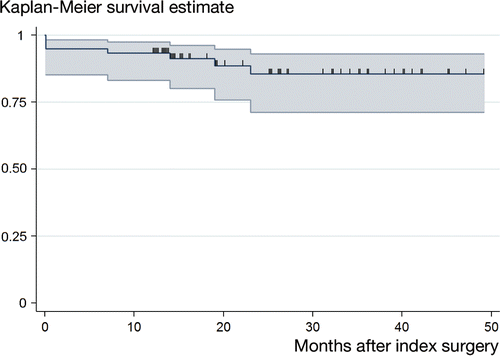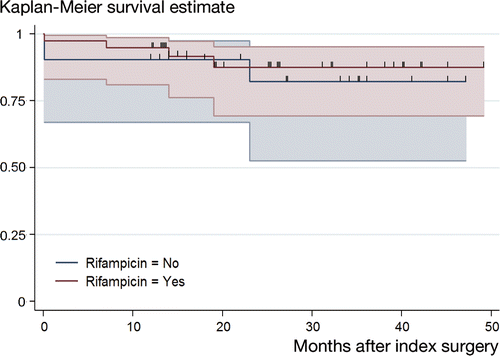Figures & data
Table 1. Patient characteristics of 60 patients with Propionibacterium-associated PJI, presented according to their postoperative antimicrobial treatment
Table 2. Surgical treatment and postoperative antimicrobial regimen in 60 patients with Propionibacterium-associated PJI, presented according to their postoperative antimicrobial treatment
Table 3. Number and types of failures in 60 patients with Propionibacterium-associated PJI, presented according to their postoperative antimicrobial treatment
Table 4. Overview of the patient characteristics of 7 failed cases treated for Propionibacterium-associated PJI
Figure 1. Kaplan-Meier survival curve of 60 patients treated for Propionibacterium-associated PJI. The cumulative success rate was 93% (95% CI: 83–97) and 86% (95% CI: 71–93) after 1 year and 2 years, respectively. The small vertical spikes represent the censored data.

Figure 2. Comparison of Kaplan-Meier survival curves of patients treated for Propionibacterium-associated PJI with and without rifampicin combination therapy. A cumulative success rate of 90% (95% CI: 67–98) and 82% (95% CI: 53–94) was found in patients treated without rifampicin after 1 year and 2 years, respectively. A cumulative success rate of 95% (95% CI: 81–99) after 1 year and 88% (95% CI: 69–95) after 2 year was reached in patients treated with rifampicin. Overall comparison of the cumulative success rates revealed a p-value of 0.7 (log-rank test). The small vertical spikes represent the censored data.

